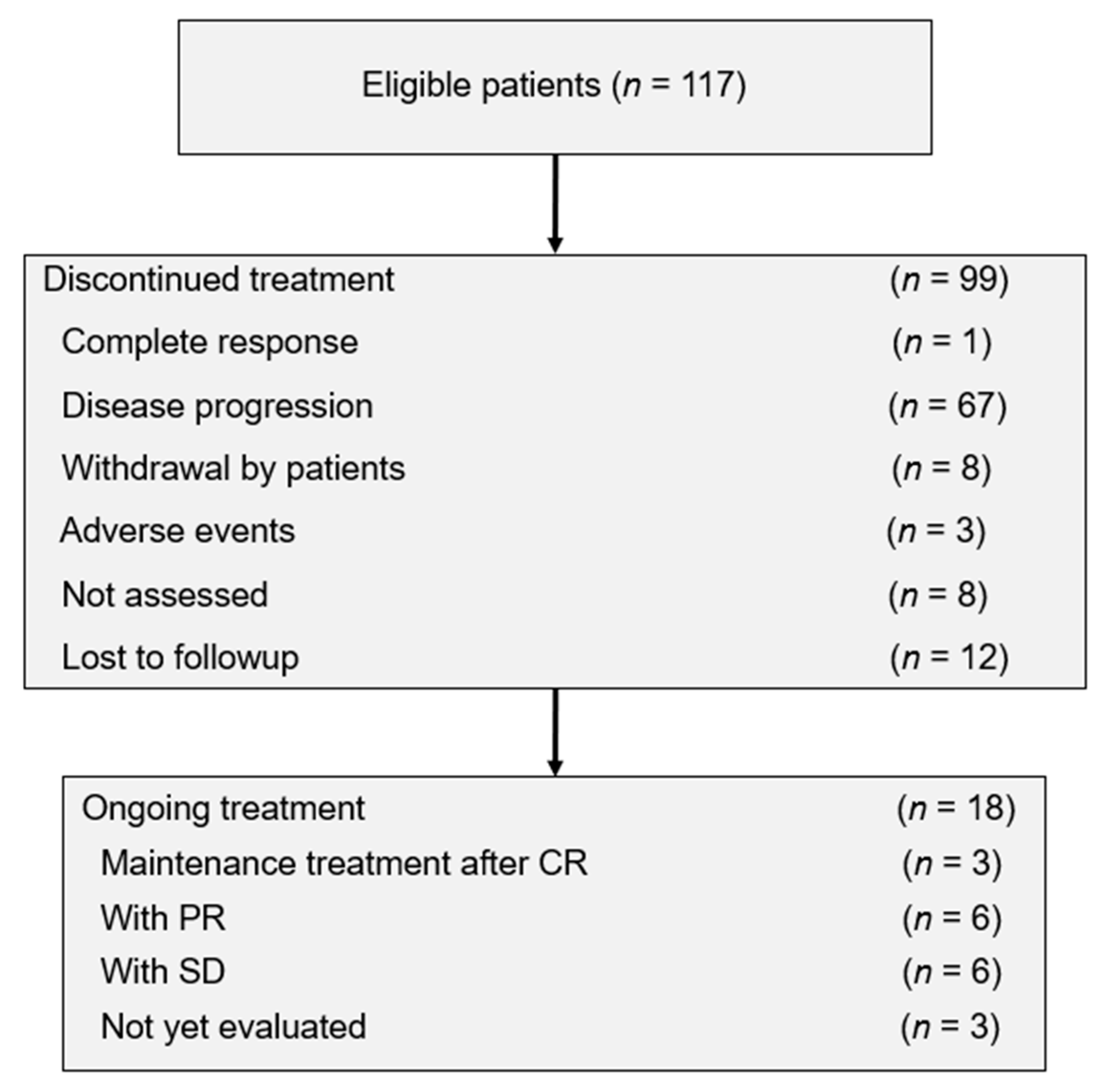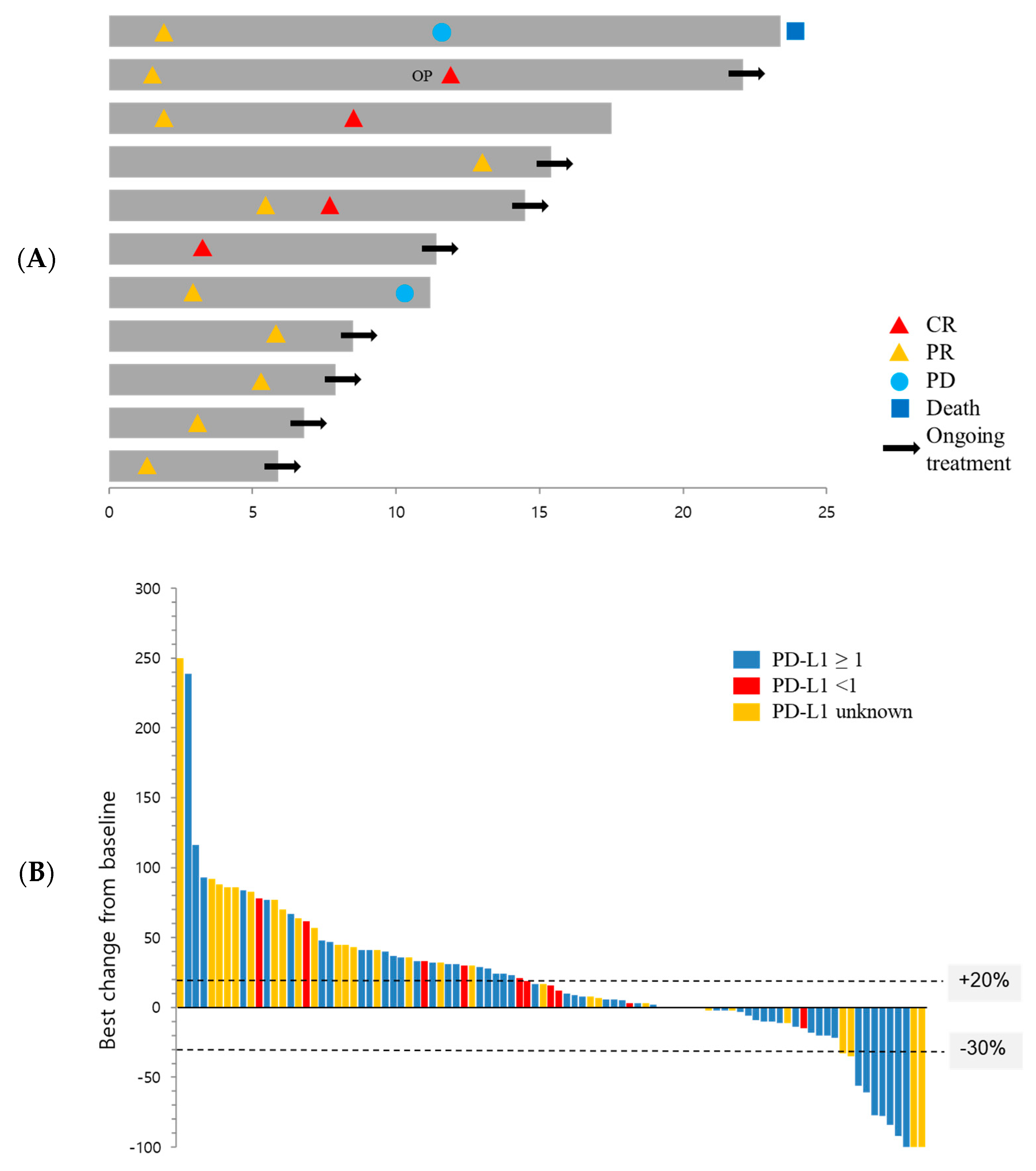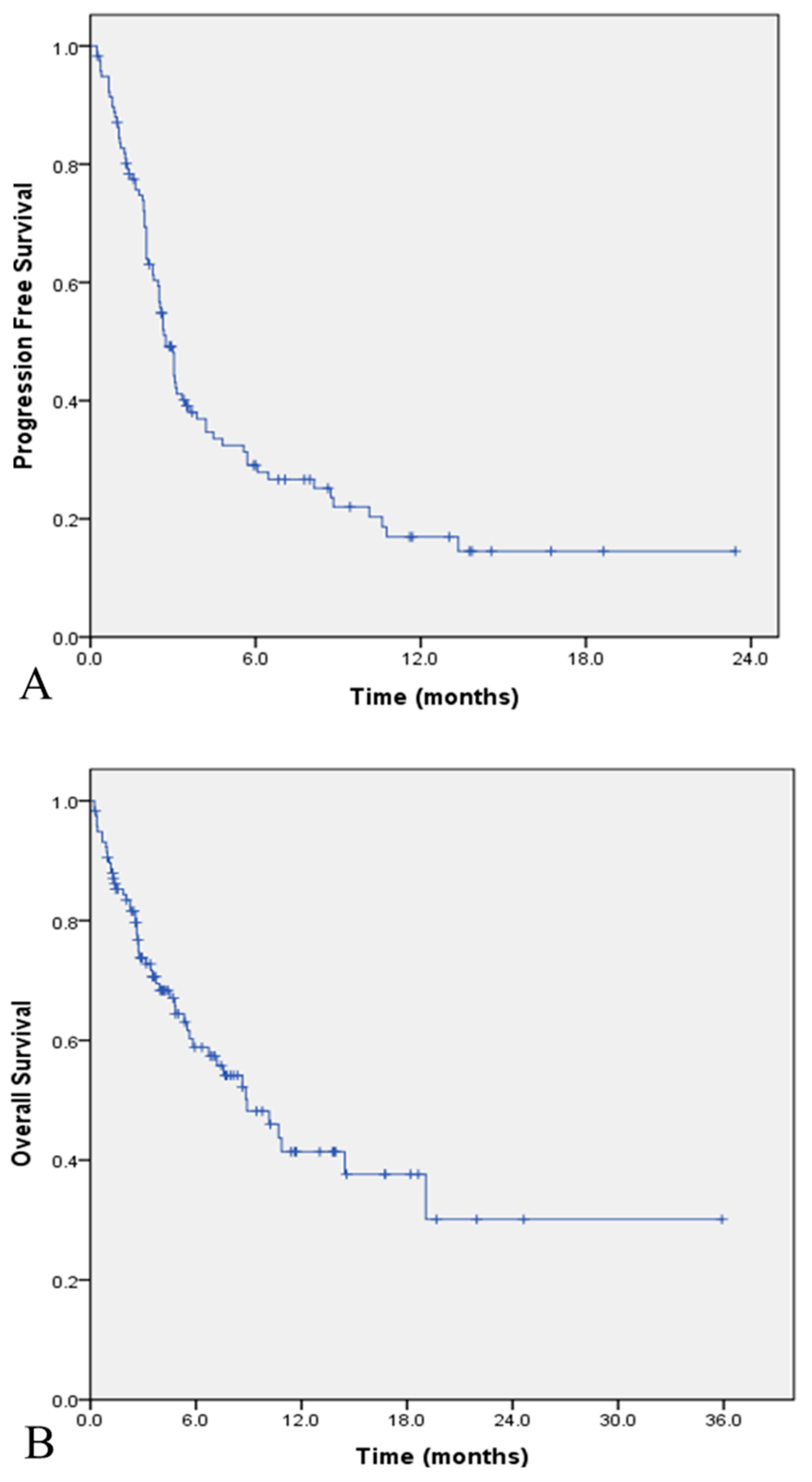Real-World Experience of Pembrolizumab Monotherapy in Patients with Recurrent or Persistent Cervical Cancer: A Korean Multi-Center Retrospective Study (KGOG1041)
Simple Summary
Abstract
1. Introduction
2. Materials and Methods
2.1. Study Design and Patients
2.2. Assessments
2.3. Primary and Secondary Objectives
3. Results
3.1. Patients
3.2. Antitumor Activity
3.3. Safety
3.4. Prognostic Factors
4. Discussion
4.1. Antitumor Activity
4.2. Adverse Events
4.3. Prognostic Marker
4.4. Limitations
5. Conclusions
Supplementary Materials
Author Contributions
Funding
Acknowledgments
Conflicts of Interest
References
- Bray, F.; Me, J.F.; Soerjomataram, I.; Siegel, R.L.; Torre, L.A.; Jemal, A. Global cancer statistics 2018: GLOBOCAN estimates of incidence and mortality worldwide for 36 cancers in 185 countries. CA A Cancer J. Clin. 2018, 68, 394–424. [Google Scholar] [CrossRef] [PubMed]
- Jung, K.-W.; Won, Y.-J.; Hong, S.; Kong, H.-J.; Lee, E.S. Prediction of Cancer Incidence and Mortality in Korea, 2020. Cancer Res. Treat. 2020, 52, 351–358. [Google Scholar] [CrossRef] [PubMed]
- Tewari, K.S.; Sill, M.W.; Long, H.J., 3rd; Penson, R.T.; Huang, H.; Ramondetta, L.M.; Landrum, L.M.; Oaknin, A.; Reid, T.J.; Leitao, M.M.; et al. Improved survival with bevacizumab in advanced cervical cancer. N. Engl. J. Med. 2014, 370, 734–743. [Google Scholar] [CrossRef] [PubMed]
- Radley, D.; Saah, A.; Stanley, M. Persistent infection with human papillomavirus 16 or 18 is strongly linked with high-grade cervical disease. Hum. Vaccines Immunother. 2015, 12, 768–772. [Google Scholar] [CrossRef] [PubMed]
- Alemany, L.; De Sanjosé, S.; Tous, S.; Quint, W.; Vallejos, C.; Shin, H.-R.; Santaella-Tenorio, J.; Alonso, P.; Lima, M.A.; Guimerà, N.; et al. Time trends of human papillomavirus types in invasive cervical cancer, from 1940 to 2007. Int. J. Cancer 2013, 135, 88–95. [Google Scholar] [CrossRef] [PubMed]
- Tashiro, H.; Brenner, M.K. Immunotherapy against cancer-related viruses. Cell Res. 2016, 27, 59–73. [Google Scholar] [CrossRef] [PubMed]
- Santin, A.D.; Bellone, S.; Gokden, M.; Cannon, M.J.; Parham, G.P. Vaccination with HPV-18 E7–Pulsed Dendritic Cells in a Patient with Metastatic Cervical Cancer. New Engl. J. Med. 2002, 346, 1752–1753. [Google Scholar] [CrossRef]
- Pardoll, D.M. The blockade of immune checkpoints in cancer immunotherapy. Nat. Rev. Cancer 2012, 12, 252–264. [Google Scholar] [CrossRef]
- Heeren, A.M.; Punt, S.; Bleeker, M.C.G.; Gaarenstroom, K.N.; Van Der Velden, J.; Kenter, G.G.; De Gruijl, T.D.; Jordanova, E.S. Prognostic effect of different PD-L1 expression patterns in squamous cell carcinoma and adenocarcinoma of the cervix. Mod. Pathol. 2016, 29, 753–763. [Google Scholar] [CrossRef]
- Meng, Y.; Liang, H.; Hu, J.; Liu, S.; Hao, X.; Wong, M.S.K.; Li, X.; Hu, L. PD-L1 Expression Correlates With Tumor Infiltrating Lymphocytes And Response To Neoadjuvant Chemotherapy In Cervical Cancer. J. Cancer 2018, 9, 2938–2945. [Google Scholar] [CrossRef]
- Frenel, J.-S.; Le Tourneau, C.; O’Neil, B.; Ott, P.A.; Piha-Paul, S.A.; Gomez-Roca, C.; Van Brummelen, E.M.; Rugo, H.S.; Thomas, S.; Saraf, S.; et al. Safety and Efficacy of Pembrolizumab in Advanced, Programmed Death Ligand 1–Positive Cervical Cancer: Results From the Phase Ib KEYNOTE-028 Trial. J. Clin. Oncol. 2017, 35, 4035–4041. [Google Scholar] [CrossRef] [PubMed]
- Naumann, R.W.; Hollebecque, A.; Meyer, T.; Devlin, M.-J.; Oaknin, A.; Kerger, J.; López-Picazo, J.M.; Machiels, J.-P.; Delord, J.-P.; Evans, T.R.J.; et al. Safety and Efficacy of Nivolumab Monotherapy in Recurrent or Metastatic Cervical, Vaginal, or Vulvar Carcinoma: Results From the Phase I/II CheckMate 358 Trial. J. Clin. Oncol. 2019, 37, 2825–2834. [Google Scholar] [CrossRef] [PubMed]
- Santin, A.D.; Deng, W.; Frumovitz, M.; Buza, N.; Bellone, S.; Huh, W.; Khleif, S.; Lankes, H.A.; Ratner, E.S.; O’Cearbhaill, R.E.; et al. Phase II evaluation of nivolumab in the treatment of persistent or recurrent cervical cancer (NCT02257528/NRG-GY002). Gynecol. Oncol. 2020, 157, 161–166. [Google Scholar] [CrossRef]
- Chung, H.C.; Ros, W.; Delord, J.-P.; Perets, R.; Italiano, A.; Shapira-Frommer, R.; Manzuk, L.; Piha-Paul, S.A.; Xu, L.; Zeigenfuss, S.; et al. Efficacy and Safety of Pembrolizumab in Previously Treated Advanced Cervical Cancer: Results From the Phase II KEYNOTE-158 Study. J. Clin. Oncol. 2019, 37, 1470–1478. [Google Scholar] [CrossRef] [PubMed]
- Tewari, K.S. Immune Checkpoint Blockade in PD-L1–Positive Platinum-Refractory Cervical Carcinoma. J. Clin. Oncol. 2019, 37, 1449–1454. [Google Scholar] [CrossRef] [PubMed]
- Grau, J.F.; Farinas-Madrid, L.; Oaknin, A. A randomized phase III trial of platinum chemotherapy plus paclitaxel with bevacizumab and atezolizumab versus platinum chemotherapy plus paclitaxel and bevacizumab in metastatic (stage IVB), persistent, or recurrent carcinoma of the cervix: The BEATcc study (ENGOT-Cx10/GEICO 68-C/JGOG1084/GOG-3030). Int. J. Gynecol. Cancer 2019, 30, 139–143. [Google Scholar] [CrossRef]
- Tewari, K.; Shapira-Frommer, R. KEYNOTE-826: A Phase 3, Randomized, Double-blind, Placebo-Controlled Study of Pembrolizumab Plus Chemotherapy for First-line Treatment of Persistent, Recurrent, or Metastatic Cervical Cancer. J. Clin. Oncol. 2019, 37. [Google Scholar] [CrossRef]
- Magee, D.; Hird, A.; Klaassen, Z.; Sridhar, S.; Nam, R.; Wallis, C.; Kulkarni, G.S. Adverse event profile for immunotherapy agents compared with chemotherapy in solid organ tumors: A systematic review and meta-analysis of randomized clinical trials. Ann. Oncol. 2020, 31, 50–60. [Google Scholar] [CrossRef]
- Le, D.T.; Durham, J.N.; Smith, K.N.; Wang, H.; Bartlett, B.R.; Aulakh, L.K.; Lu, S.; Kemberling, H.; Wilt, C.; Luber, B.S.; et al. Mismatch repair deficiency predicts response of solid tumors to PD-1 blockade. Science 2017, 357, 409–413. [Google Scholar] [CrossRef]
- Dudley, J.C.; Lin, M.-T.; Le, D.T.; Eshleman, J.R. Microsatellite Instability as a Biomarker for PD-1 Blockade. Clin. Cancer Res. 2016, 22, 813–820. [Google Scholar] [CrossRef]
- Marabelle, A.; Le, D.T.; Ascierto, P.A.; Di Giacomo, A.M.; De Jesus-Acosta, A.; Delord, J.-P.; Geva, R.; Gottfried, M.; Penel, N.; Hansen, A.R.; et al. Efficacy of Pembrolizumab in Patients With Noncolorectal High Microsatellite Instability/Mismatch Repair–Deficient Cancer: Results From the Phase II KEYNOTE-158 Study. J. Clin. Oncol. 2020, 38, 1–10. [Google Scholar] [CrossRef] [PubMed]
- Latham, A.; Srinivasan, P.; Kemel, Y.; Shia, J.; Bandlamudi, C.; Mandelker, D.; Middha, S.; Hechtman, J.; Zehir, A.; Dubard-Gault, M.; et al. Microsatellite Instability Is Associated With the Presence of Lynch Syndrome Pan-Cancer. J. Clin. Oncol. 2019, 37, 286–295. [Google Scholar] [CrossRef] [PubMed]
- Cortes-Ciriano, I.; Lee, S.; Park, W.-Y.; Kim, T.-M.; Park, P.J. A molecular portrait of microsatellite instability across multiple cancers. Nat. Commun. 2017, 8, 15180. [Google Scholar] [CrossRef]
- Davis, A.A.; Patel, V.G. The role of PD-L1 expression as a predictive biomarker: An analysis of all US Food and Drug Administration (FDA) approvals of immune checkpoint inhibitors. J. Immunother. Cancer 2019, 7, 1–8. [Google Scholar] [CrossRef]
- Mezache, L.; Paniccia, B.; Nyinawabera, A.; Nuovo, G.J. Enhanced expression of PD L1 in cervical intraepithelial neoplasia and cervical cancers. Mod. Pathol. 2015, 28, 1594–1602. [Google Scholar] [CrossRef] [PubMed]
- Spigel, D.R.; McCleod, M.; Jotte, R.M.; Einhorn, L.; Horn, L.; Waterhouse, D.M.; Creelan, B.; Babu, S.; Leighl, N.B.; Chandler, J.C.; et al. Safety, Efficacy, and Patient-Reported Health-Related Quality of Life and Symptom Burden with Nivolumab in Patients with Advanced Non–Small Cell Lung Cancer, Including Patients Aged 70 Years or Older or with Poor Performance Status (CheckMate 153). J. Thorac. Oncol. 2019, 14, 1628–1639. [Google Scholar] [CrossRef]
- Middleton, G.W.; Brock, K.; Savage, J.; Mant, R.; Summers, Y.; Connibear, J.; Shah, R.; Ottensmeier, C.; Shaw, P.; Lee, S.-M.; et al. Pembrolizumab in patients with non-small-cell lung cancer of performance status 2 (PePS2): A single arm, phase 2 trial. Lancet Respir. Med. 2020, 8, 895–904. [Google Scholar] [CrossRef]



| Characteristic | No. (%) |
|---|---|
| Age, Years | |
| Median, range | 53 (28–79) |
| ECOG performance status | |
| 0 | 16 (13.7%) |
| 1 | 37 (31.6%) |
| 2 | 45 (38.5%) |
| 3 | 16 (13.7%) |
| 4 | 3 (2.6%) |
| FIGO stage at diagnosis | |
| I | 31 (26.5%) |
| II | 34 (29.1%) |
| III | 22 (18.8%) |
| IV | 27 (23.1%) |
| Unknown | 3 (2.6%) |
| HPV test result | |
| Positive ^ | 57 (48.7%) |
| Negative | 14 (12.0%) |
| Unknown | 46 (39.3%) |
| PD-L1 expression * | |
| 1≤ | 60 (51.3%) |
| 1> | 12 (10.3%) |
| Unknown | 45 (38.5%) |
| Histology | |
| Squamous cell carcinoma | 88 (75.2%) |
| Adenocarcinoma | 19 (16.2%) |
| Adenosquamous cell carcinoma | 4 (3.4%) |
| Neuroendocrine cell carcinoma | 4 (3.4%) |
| Glassy cell carcinoma | 1 (0.9%) |
| Basaloid squamous cell carcinoma | 1 (0.9%) |
| Target lesion size, mm # | |
| Median, range | 67 (10–529) |
| Previous radiation therapy | 50 (42.7%) |
| (CC)RTx | 38 (76.0%) |
| (CC)RTx + hysterectomy | 12 (24.0%) @ |
| Previous surgery | 62 (53.0%) |
| RH | 17 (27.4%) % |
| RH + (CC)RTx | 45 (72.6%) & |
| Number of previous lines of chemotherapy | |
| 1 | 38 (32.5%) |
| 2 | 43 (36.8%) |
| 3 | 24 (20.5%) |
| 4 | 8 (6.8%) |
| ≥5 | 4 (3.4%) |
| Anti-Tumor Activity | Total Population | Favorable PS Group (ECOG ≤1) |
|---|---|---|
| n = 117 | n =53 | |
| Best overall response | ||
| CR | 3 (2.6%) | 3 (5.7%) |
| PR | 8 (6.8%) | 7 (13.2%) |
| SD | 28 (23.9%) | 14 (26.4%) |
| PD | 67 (57.3%) | 26 (49.1%) |
| Not able to be assessed | 11 (9.4%) | 3 (5.7%) |
| Objective response rate | 11 (9.4%) | 10 (18.9%) |
| 95% CI | 4.8 to 16.2 | 9.4 to 32.0 |
| Disease control rate | 39 (33.3%) | 24 (45.3%) |
| 95% CI | 24.9 to 42.6 | 31.6 to 59.6 |
| Time to response, months # | ||
| Median (range) | 2.8 (1.3–13.1) | 3.0 (1.3–13.1) |
| Duration of response, months #,& | ||
| Median (range) | NR (8.9–NR) | 8.9 (7.3–10.4) |
| Duration of response, months #,* | (n = 11) | (n = 10) |
| ≥6 | 6 (54.5%) | 5 (50.0%) |
| ≥9 | 4 (36.4%) | 3 (30.0%) |
| ≥12 | 2 (18.2%) | 1 (10.0%) |
| Adverse Event | Any Grade | Grade 3/4 |
|---|---|---|
| Any AE | 55 (47.0%) | 8 (6.8%) |
| Hypothyroidism | 9 (7.7%) | 0 |
| Fatigue | 5 (4.3%) | 0 |
| Skin rash | 5 (4.3%) | 2 (1.7%) |
| Anemia | 4 (3.4%) | 1 (0.9%) |
| AST/ALT elevated | 3 (2.6%) | 1 (0.9%) |
| Nausea | 3 (2.6%) | 0 |
| Abdominal pain | 3 (2.6%) | 0 |
| Dyspnea | 3 (2.6%) | 0 |
| Colitis | 2 (1.7%) | 1 (0.9%) |
| Neutropenia | 2 (1.7%) | 1 (0.9%) |
| Thrombocytopenia | 2 (1.7%) | 0 |
| Hyperphosphatemia | 2 (1.7%) | 0 |
| Hypoalbuminemia | 2 (1.7%) | 0 |
| Renal insufficiency | 2 (1.7%) | 0 |
| Cough | 2 (1.7%) | 0 |
| Hyperthyroidism | 1 (0.9%) | 0 |
| Pneumonitis with pulmonary edema | 1 (0.9%) | 1 (0.9%) |
| Constipation | 1 (0.9%) | 0 |
| Vomiting | 1 (0.9%) | 0 |
| Dizziness | 1 (0.9%) | 0 |
| Guillain-Barré syndrome | 1 (0.9%) | 1 (0.9%) |
| Any AE leading to discontinuation | ||
| Guillain-Barre syndrome | 1 | 1 |
| Colitis | 1 | 1 |
| Pneumonitis with pulmonary edema | 1 | 1 |
| Predictive Factors | Univariate Analysis | |
|---|---|---|
| OR (95% CI) | p-Value | |
| HPV test result | ||
| Negative | 1 | |
| Positive | 1.529 (0.169–13.842) | 0.705 |
| Histology | ||
| Non-SqCC | 1 | |
| SqCC | 3.590 (0.439–29.329) | 0.233 |
| Number of prior lines of chemotherapy | ||
| ≤2 | 1 | |
| ≥3 | 1.315 (0.328–5.263) | 0.699 |
| ECOG performance status | ||
| ≥2 | 1 | |
| ≤1 | 14.651 (1.809–118.675) | 0.012 |
| PD-L1 expression | ||
| <20 | 1 | |
| ≥20 | 2.133 (0.440–10.338) | 0.347 |
| Burden of tumor # | ||
| <2cm | 1 | 0.120 |
| 2cm≤ <5cm | 1.429 (0.244–8.375) | |
| 5cm≤ <10cm | 0.270 (0.34–2.165) | |
| ≥10cm | 0.192 (0.016–2.363) | |
| Study | Keynote028 | Keynote158 | Checkmate358 | NRG-GY002 | Present Study | |
|---|---|---|---|---|---|---|
| Total population | Favorable PS group | |||||
| Phase | IB | II | I/II | II | Retro | Retro |
| Drug | Pembrolizumab 10mg/kg q2w | Pembrolizumab 200mg q3w | Nivolumab 240mg q2w | Nivolumab 3mg/kg q2w | Pembrolizumab 200mg q3w | Pembrolizumab 200mg q3w |
| N | 24 | 98 | 19 | 25 | 117 | 53 |
| Age, median (age) | 42 | 46 | 51 | 45 | 53 | 52 |
| Histology of SqCC | 23 (96%) | 92 (94%) | 19 (100%) | 15 (60%) | 88 (75%) | 42 (79%) |
| ECOG ≤1 | 24 (100%) | 98 (100%) | 18 (95%) | 25(100%) | 53 (45%) | 53 (100%) |
| Prior lines CTx ≥3 | 9 (38%) | 30 (31%) | 0 | N/A | 36(31%) | 15 (28%) |
| Positive PD–L1 expression | 24 (100%) * | 82 (84%) # | 10 (53%) % | 17(77%) # | 57(49%) $ | 30 (57%) $ |
| BOR | ||||||
| CR | 0 | 3 (3%) | 3 (16%) | 0 | 3 (3%) | 3 (6%) |
| PR | 4 (17%) | 9 (8%) | 2 (10%) | 1 (4%) | 8 (7%) | 7 (13%) |
| SD | 3 (13%) | 18 (18%) | 8 (42%) | 9 (36%) | 28 (24%) | 14 (26%) |
| PD | 16 (67%) | 55 (56%) | 6 (32%) | 11 (44%) | 67 (57%) | 26 (49%) |
| Not evaluable | 1 (4%) | 13 (13%) | 0 | 4 (16%) | 11 (0%) | 3 (6%) |
| ORR | 4 (17%) | 12(12%) | 5 (26%) | 1 (4%) | 11 (9%) | 10 (19%) |
| DCR | 7 (29%) | 30 (31%) | 13 (68%) | 10 (40%) | 39 (33%) | 24 (45%) |
| Time to response, months Median (range) | 1.9 (1.7–8.2) | 2.1(1.6–4.1) | 1.7 (1.6–1.9) | N/A | 2.8 (1.4–13.4) | 3.0 (1.4–13.4) |
| Duration of response, monthsMedian (range) | 5.4 (4.1–7.5) | NR (≥3.7–≥18.6) | NR (23.3–29.5) | 3.8 | NR (8.9-NR) | 8.9 (7.3–10.4) |
| AE ≥3 | 5 (21%) | 12 (12%) | 4(21%) | 6 (24%) | 8 (7%) | 3 (6%) |
| PFS at 6m | 21% | 25% | 36% | 16% | 30% | 44% |
| OS at 6m, 12m | 67%, 40% | 75%, 41% | 89%, 78% | 78% | 59%, 41% | 84%, 57% |
Publisher’s Note: MDPI stays neutral with regard to jurisdictional claims in published maps and institutional affiliations. |
© 2020 by the authors. Licensee MDPI, Basel, Switzerland. This article is an open access article distributed under the terms and conditions of the Creative Commons Attribution (CC BY) license (http://creativecommons.org/licenses/by/4.0/).
Share and Cite
Choi, M.C.; Kim, Y.-M.; Lee, J.-W.; Lee, Y.J.; Suh, D.H.; Lee, S.J.; Lee, T.S.; Lee, M.; Park, D.C.; Kim, M.K.; et al. Real-World Experience of Pembrolizumab Monotherapy in Patients with Recurrent or Persistent Cervical Cancer: A Korean Multi-Center Retrospective Study (KGOG1041). Cancers 2020, 12, 3188. https://doi.org/10.3390/cancers12113188
Choi MC, Kim Y-M, Lee J-W, Lee YJ, Suh DH, Lee SJ, Lee TS, Lee M, Park DC, Kim MK, et al. Real-World Experience of Pembrolizumab Monotherapy in Patients with Recurrent or Persistent Cervical Cancer: A Korean Multi-Center Retrospective Study (KGOG1041). Cancers. 2020; 12(11):3188. https://doi.org/10.3390/cancers12113188
Chicago/Turabian StyleChoi, Min Chul, Yong-Man Kim, Jeong-Won Lee, Yong Jae Lee, Dong Hoon Suh, Sung Jong Lee, Taek Sang Lee, Maria Lee, Dong Choon Park, Min Kyu Kim, and et al. 2020. "Real-World Experience of Pembrolizumab Monotherapy in Patients with Recurrent or Persistent Cervical Cancer: A Korean Multi-Center Retrospective Study (KGOG1041)" Cancers 12, no. 11: 3188. https://doi.org/10.3390/cancers12113188
APA StyleChoi, M. C., Kim, Y.-M., Lee, J.-W., Lee, Y. J., Suh, D. H., Lee, S. J., Lee, T. S., Lee, M., Park, D. C., Kim, M. K., Lee, J.-M., Shim, S.-H., Jeon, S., Min, K. J., Kim, M. K., Kim, B. W., Park, J. Y., Kim, B.-G., Kim, D. Y., ... Lee, J.-Y. (2020). Real-World Experience of Pembrolizumab Monotherapy in Patients with Recurrent or Persistent Cervical Cancer: A Korean Multi-Center Retrospective Study (KGOG1041). Cancers, 12(11), 3188. https://doi.org/10.3390/cancers12113188








